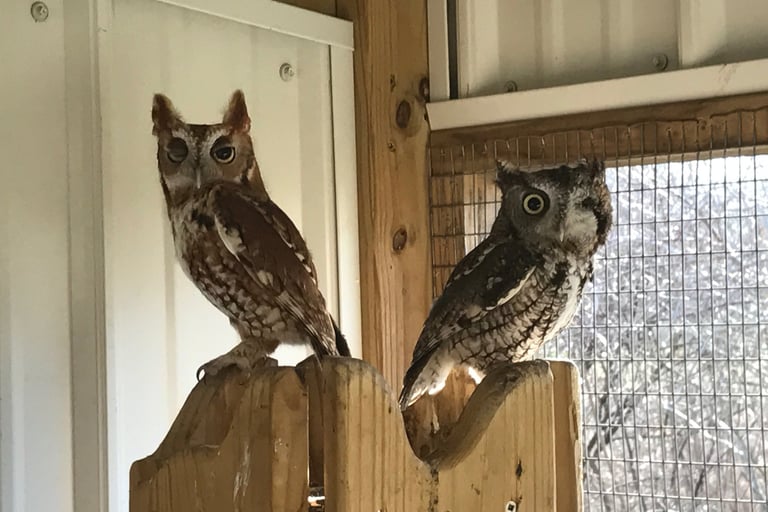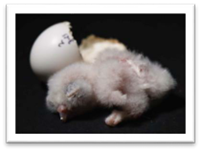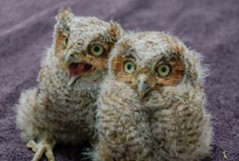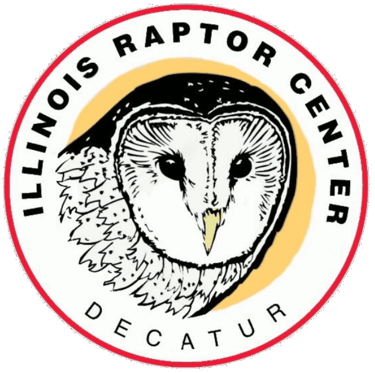Illinois Raptor Center
Avian Conservation through Captive Propagation Data Collection & Education
The Illinois Raptor Center (IRC) hadn’t considered breeding raptors when we first began rehabilitating and presenting conservation education programs back in 1991. It was in 2018, when Scarlett and Wink laid eggs that were viable, that we unintentionally stumbled into the world of captive breeding. Both Scarlett and Wink, Eastern Screech Owls (EASO), were admitted to our wildlife hospital in 2013. Both were branchers. Both had eye injuries
that made them non-releasable. Both were put in our education programs
and became Wildlife Ambassadors. For years they housed together and
were thought to be females. It turns out we were wrong. Wink is a male.
Breeding native raptors requires an Illinois Department of Natural Resources Raptor Propagation Permit and a USFWS Raptor Propagation Permit. To be consistent with the wildlife law, we quickly called our IDNR Permit Office and our USFWS Region 3 Migratory Bird Permit Office to explain our situation and apply for the permits. These permits are not issued to organizations so our permits were issued to Jacques Nuzzo, IRC Program Director. Jacques received both permits in a timely manner.
No one knows why but EASOs are known to eat their chicks in captivity. To be safe, we removed the eggs from the parents and started incubating them ourselves. From those eggs, we hand-raised four chicks. Because our organization is adamant about data collection, Jacques took pictures of the chicks in the eggs, pictures as they hatched, and a picture every day of their lives until they fully feathered. This year (2019) Jacques is getting even more data. This is a valuable resource in rehab to be able to identify the ages of EASOs admitted to our hospital in the future.
When we want a certain species for presentations, a species normally not seen in our area or rarely comes into our hospital, the IRC has purchased captive bred birds. These are raptors that people love, want to see up-close, and are eager to learn about. Because we are falconers as well as rehabilitators, we were not surprised at how much time and money it takes to hand-raise a raptor. In our nearly 30 years, the IRC has purchased 3 Barn Owls ($500 each) and 2 Snowy Owls ($3,000 each) for our education presentations. And from our experience, captive bred owls are wonderful ambassadors and worth the expense if you do serious education. This leads us to the position statement put out by the International Association of Avian Trainer and Educators (IAATE) in March 2018. “IAATE supports the use of human-reared owls in ambassador animal programs. IAATE strongly discourages the use of parent-reared owls in ambassador animal programs.” ....”When it comes to adaptability, parent-reared owls are unlike human-reared owls because they lack a history of positive affiliation with human caregivers and also lack positive exposure to the circumstances and stimuli encountered in the human world.” Read the full position statement on their website:
So, because of what we are learning from data collection and for being able to provide other facilities with Wildlife Ambassadors for Conservation Education, we have decided to continue with and possibly even expanding the IRC Raptor Propagation Program.
Avian Conservation through Captive Propagation
The IRC breeds a small number of Eastern Screech Owletsfor exclusive use in conservation education presentations.Eastern Screech Owlets hatching in captivity at the IRC are cared for entirely by staff members under the supervision of Jacques Nuzzo. . Please make it known if you have color preferences.
Fee.......................
A $520 donation to the Illinois Raptor Center to cover time and expense is required at delivery. Health certificates, if needed, should be obtained by the recipient within two weeks of delivery, and the IRC will provide another owlet or reimburse fees if the owlet is deemed unhealthy or physically impaired. Recipient arranges and pays any shipping fees. (pickup is preferred) We do not export out of the country.
This is our information:
Jacques Nuzzo (IRC) is permitted by the Illinois Department of Natural Resources and United States Fish & Wildlife Service, and the United States Geological Survey Bird Banding Laboritory in the areas of wildlife rehabilitation, conservation education, falconry, eagles, endangered species, raptor propagation, and banding. The IRC is also certified by the United States Department of Agriculture. Jacques, IRC Program Director, and Jane Seitz, IRC Executive Director, have combined, nearly 70 years of experience in the field of raptors. The IRC 501(c)(3) nonprofit organization established in 1991 is in good standing. FEIN 37-1287919 website: ww.illinoisraptor.center facebook:www.facebook.com/illinoisbirds
The IRC feeds only quality raptor food purchased from reputable breeders/vendors. The IRC does NOT feed: donated grocery store bought meat from home freezers, donated wild meat shot with lead shot, alive or dead wildlife patients, road-kill, or bird of prey diet products.
The IRC does both on-site and outreach programs, including large yearly venues such as Starved Rock Eagle Days in Illinois and the International Festival of Owls in Minnesota, as well as small on-site Personal Raptor Experiences for Two and Adult Raptor Camps. Sponsors for our programs include the IDNR, USFWS, USACE, and Ameren Illinois, schools, Audubon Societies, and Conservation Districts.
The IRC’s 25-acre property is located at 5695 W. Hill Road, Decatur, IL 62522, along the Sangamon River. We have an office building with nature center and 30 outdoor mews for our education raptors. We have a wildlife hospital building, 36 outdoor mews for rehabilitation, a temperature controlled staging building for birds that are subject to extreme hot or cold temperatures, a barn flight, and a 409’ long flight facility for rehabilitation - the largest flight thought to be in the United States.
Send all inquiries to Jacques at illinois.raptors@gmail.com with your information: (Please let him know if you would like more than one owlet and if you have a color or sex preference.
USFWS Special Purpose Possession – Live and Dead Migratory Birds for Educational Use Permit
State education permits if applicable
501(c)(3) nonprofit status FEIN #
Website and Facebook addresses
Experience/years in raptor handling, care, and management
Food items and source/s
Number and types of conservation education programs each year
Raptor housing facilities (provide pictures)






